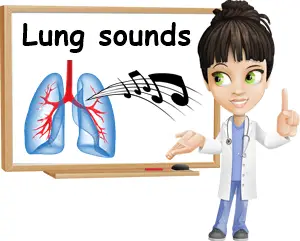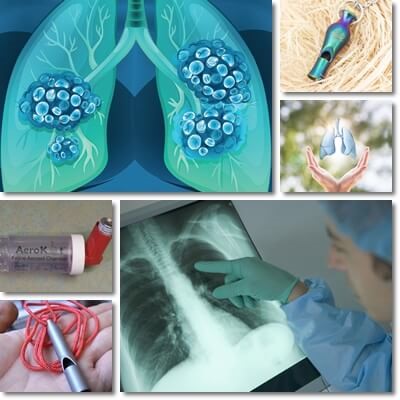Lung sounds are a common occurrence among people of all ages, especially those suffering from a chronic respiratory condition or infection or having recently gotten over a more serious respiratory tract infection. Different types of lung sounds may occur, the most common being whistling, wheezing and stridor. Whenever they occur, lung sounds represent a reason for concern and require medical attention. Although not always a serious symptom, breathing sounds in general are best investigated by a medical professional to rule out any underlying conditions that may be causing them and prevent possible complications of existing chronic conditions.
What causes lung sounds?
The following are some of the most likely causes of lung sounds:
1) CPOD, or chronic obstructive pulmonary disease. CPOD refers to a type of chronic (severe and long-term) lung disease characterized by inflammation, obstruction of the airways, limitation of breathing and often increased likelihood of respiratory infections. CPOD affects the lung tissue and smaller airways known as bronchioles and alveoli (essentially air sacs responsible for carbon dioxide and oxygen transfer in breathing).

The disease is progressive, meaning it worsens over time; the lung damage it produces is, for the most part, irreversible. Measures can be taken to slow down progression and improve quality of life. Chronic obstructive pulmonary disease groups symptoms of chronic bronchitis and emphysema. What causes CPOD is smoking, air pollution, inhalation of toxic or irritant fumes and genetics. Symptoms include chronic cough, with or without mucus production, shortness of breath (at first only following physical effort or exercise), feeling of tiredness, muscle wasting and breathing sounds such as wheezing.
2) Bronchitis. There are two major types of bronchitis: acute and chronic. Both types cause inflammation of the bronchi- the largest and second largest airway passages that conduct air into the lungs. Acute bronchitis is usually a viral infection, but can also be caused by bacteria or fungi too (see Difference between Bacteria, Viruses and Fungi). Symptoms include dry and productive cough that lasts up to 3 weeks or, more rarely, over a month, shortness of breath, fever, tiredness, malaise and wheezing, snoring or whistling sounds called ronchi.
Chronic bronchitis is characterized by an usually productive cough that lasts around 2-3 months per year and occurs several years in a row. Causes range from smoking, occupation exposure to toxic or irritant fumes, bacterial, viral and other types of infections and air pollution. Chronic bronchitis is considered a form of CPOD, chronic obstructive pulmonary disease. Symptoms include long-term, recurring, productive cough with unusual mucus colors, shortness of breath and abnormal breathing noises such as wheezing or whistling sounds coming from the lungs. See What Nose Mucus Color Means.

3) GERD, gastroesophageal reflux disease or acid reflux. Acid reflux causes stomach contents with gastric juices to rise up into the esophagus and produce irritation of the mucous membranes. Gastric juices that escape the stomach can sometimes be inhaled and cause lung inflammation. This is called aspiration pneumonia or chemical pneumonia and produces symptoms such as coughing, breathing difficulties, shortness of breath, chest pain, burning sensation or heartburn feeling and unusual lung sounds such as wheezing or gurgling sounds when breathing. See Water Aspiration into Lungs: Causes, Symptoms and Treatment.
4) Heart failure with pulmonary edema. In heart failure, the heart cannot efficiently pump blood which results in shortness of breath, fatigue, rapid breathing and water retention manifesting as swollen legs or ankles or swollen abdomen, fluid in the lungs. Unusual breathing sounds may be a sign fluid is accumulating in the lungs and may manifest as lung sounds called crackles or rales which are essentially sharp snapping noises that may vary in pitch and intensity.
5) Lung cancer. Lung sounds or breathing noises caused by lung cancer may manifest differently depending on the type of cancer and its stage. For the most part, long-time smokers, factory workers or anyone with a risk of lung cancer from occupational exposure and people over 65 years of age should consider seeing a doctor if they experience different kinds of lung sounds or breathing noises.
6) Vocal cords problems. Surgery, nodules, masses and various other problems affecting the vocal cords may cause breathing noises that may be mistaken for lung sounds. If vocal cords are affected, hoarseness or loss of voice may be present along with other symptoms. See your doctor for tests.
7) Anaphylactic shock. Allergic reactions building up to anaphylactic shock ultimately affect breathing and may cause unusual sounds such as wheezing or whistling. Read more about Anaphylactic Shock: Causes, Symptoms and Treatment. Seek medical help immediately if you notice symptoms of an anaphylactic shock. Anaphylaxis is a medical emergency.
8) Asthma. Asthma is a chronic, inflammatory condition of the lungs. It may be triggered by allergens such as pollen, pet hair, dust and dust mites, mold, exercise, allergenic foods, irritant chemicals and increase in severity of respiratory infections. During an asthma attack, wheezing is likely to occur and be severe.
9) Respiratory infections: pneumonia, bronchiolitis, flu or cold. Respiratory system infections, irrespective of their nature (viral, bacterial, fungal), commonly cause breathing problems and associated breathing sounds, many of which affect the lungs primarily. Wheezing or whistling sounds are the most common, but ronchi or stridor may also occur.
What are lung sounds like?
Lung sounds are essentially abnormal breathing sounds that may be heard when inhaling, exhaling or both. Some types of lung sounds can only be heard through auscultation with the help of a stethoscope, while others may be clearly heard without the need for any medical instruments. Some of these sounds are specific to certain conditions. The following are the most common lung sounds descriptions with audio:
1) Wheezing. Wheezing is like a faint whistling sound that occurs when inhaling or exhaling air or both. It’s continuous, high-pitched and similar to hissing. It usually indicates an obstruction of the airways, potentially caused by excess mucus production due to an infection or inflammation of other causes. More commonly, a wheezing or whistling sound in lungs on exhale indicates a respiratory infection (example: bronchitis). The sound may occur in chronic lung disease, allergies, asthma or acid reflux, foreign bodies or tumors. Excessive wheezing should be seen by a doctor.
2) Stridor. Essentially a type of wheezing, stridor is a more high-pitched, continuous wheezing-type of sound. It often occurs during inspiration, but may be present during expiration or both. It can be caused by a foreign object in the airways, tumor masses, infections (croup), edema, thyroid disease, allergic reactions, laryngospasms etc.
3) Crackling sounds. Also called lung rales, they are crackling or rattling sounds, usually brief, discontinuous. They may occur in one or both lungs, usually during expiration. What lung crackles mean is there may be a chance of pulmonary edema as seen in heart failure or they may indicate various lung diseases, pneumonia, for example.
Remedies and solutions for lung sounds
If you ever hear a whistle noise when breathing or other breathing sounds, it’s important to you make an appointment with your doctor and have some tests to see what is causing these noises. Depending on the cause, your doctor will prescribe the best treatment for you. Other than this, the following may serve to prevent and manage conditions that cause lung sounds:
1) Stop smoking and avoid second-hand smoking.
2) Avoid irritant chemicals, including household cleaning agents.
3) Reduce allergy triggers. For pollen allergies, avoid going out on windy days, have water and your essential medication with you at all times, stay hydrated, avoid foods that cause acid reflux, change clothes when you come home, keep windows closed when pollen count is high (especially in the mornings), use air conditioning at home and in the car, use a humidifier to prevent dry air, wash hair often.
4) Keep house warm, not too dry (to avoid asthma episodes and laryngospasms), not too humid (to avoid lung problems).
5) Manage acid reflux, whether symptomatic or asymptomatic.
See Foods to Eat and to Avoid for Acid Reflux.
6) Maintain a healthy body weight and eat a clean diet.
7) Take the medication your doctor prescribed, as advised.
8) Wash hands often, especially before eating, to prevent viral and bacterial infections.
During flu season, take all preventive measures to reduce infection risks (example: avoid crowded places, have a flu shot well before the season begins) and manage any respiratory infection with adequate treatment (if necessary), good nutrition, ensure proper hydration levels and enjoy good rest.
